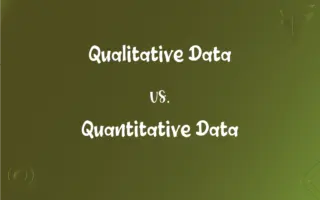Square vs. Rectangle: What's the Difference?
Edited by Janet White || By Harlon Moss || Updated on October 10, 2023
A square has all sides equal and all angles 90°; a rectangle has opposite sides equal with all angles 90°.

Key Differences
Square and rectangle, both quadrilaterals, are staples in geometrical studies and daily life applications. A square is a special type of rectangle, characterized by having all its sides equal in length. Simultaneously, a rectangle possesses a distinct trait of having its opposite sides equal, demonstrating a uniform yet flexible aspect in its structure. So, while every square is a rectangle due to its 90° angles, not every rectangle can be a square.
Squares are synonymous with congruency in all aspects, radiating symmetry from every corner and side. Rectangles, while maintaining parallelism and equal length for opposite sides, allow for dissimilarity in the measure between length and breadth. This vital discrepancy between squares and rectangles spawns a myriad of practical applications and architectural considerations, offering a versatile or symmetric choice.
In art and design, squares often symbolize balance and equality due to their equilateral and equiangular nature. Conversely, rectangles offer an elongation or compression aesthetic, providing a distinct, perhaps dynamic or stable visual depending upon orientation. Therefore, the utilization of a square or a rectangle can distinctly influence the aesthetic and balance of a design, impacting perception and interaction.
In mathematical and computational applications, the properties of squares and rectangles serve different purposes. Squares, with their equal sides, often simplify calculations and are straightforward in spatial estimations. In contrast, rectangles cater to diverse problems where varied side lengths are required, enabling a broader application in problem-solving scenarios.
In the world of architecture and urban planning, squares offer a classic, symmetrical, and balanced design, often used in courtyards and plazas. Meanwhile, rectangles provide a utilitarian approach, catering to a variety of spaces like rooms, blocks, or parks, where length may need to dominate over breadth or vice versa. Both the square and rectangle, though similar, offer distinctly different applications and aesthetic impacts, ingrained in our cultural, technological, and natural world.
ADVERTISEMENT
Comparison Chart
Definition
All sides and angles equal
Opposite sides equal, angles 90°
Symmetry
All sides and angles
Only angles
Area Calculation
Side^2
Length x Breadth
Perimeter Calculation
4 x Side
2 x (Length + Breadth)
Diagonal Length
Side x √2
√(Length^2 + Breadth^2)
ADVERTISEMENT
Square and Rectangle Definitions
Square
A square is a polygon with four equal sides and four equal angles.
The chessboard consists of 64 squares, alternately colored black and white.
Rectangle
A rectangle is a quadrilateral with opposite sides equal and four right angles.
The screen of most televisions and monitors is shaped like a rectangle.
Square
In algebra, a square refers to a number multiplied by itself.
The square of 5 is 25, providing a simple numerical base in various calculations.
Rectangle
In art, a rectangle often denotes a canvas or frame shape, longer in one dimension.
Leonardo da Vinci's Mona Lisa is painted on a rectangular canvas.
Square
A square can also refer to a public meeting place or plaza, often quadrilateral in shape.
The protesters gathered in the city square to voice their demands to the government.
Rectangle
In spatial design, a rectangle refers to spaces or objects with elongated sides.
The swimming pool was designed as a long rectangle to facilitate lap swimming.
Square
In geometry, a square signifies a regular quadrilateral, balancing sides and angles.
The Pythagorean theorem involves the square of the hypotenuse in a right-angled triangle.
Rectangle
Informally, "rectangle" can also signify something that is distinctly elongated in shape.
The chocolate bar was a small rectangle, perfect for a quick snack.
Square
In casual language, “square” might mean to resolve or settle something, often a debt.
After dinner, they decided to square up the bill by each paying an equal share.
Rectangle
In mathematics, rectangles serve as a fundamental shape for area and perimeter calculations.
The area of a rectangle is found by multiplying its length by its width.
Square
A polygon having four equal sides and four equal angles.
Rectangle
A four-sided plane figure with four right angles.
Square
Something having an equal-sided rectangular form
A square of cloth.
Rectangle
(geometry) Any quadrilateral having opposing sides parallel and four right angles.
Rectangle
(nontechnical) Such a quadrilateral that is oblong (longer than it is wide): one that is not regular (equilateral), that is, any except a square.
Rectangle
A four-sided figure having only right angles; a right-angled parallelogram.
Rectangle
Rectangular.
Rectangle
A parallelogram with four right angles
FAQs
How do you calculate the area of a square?
Multiply the length of one side by itself.
Do all squares qualify as rectangles?
Yes, because a square has all the properties of a rectangle – opposite sides equal and right angles.
What is the significance of squares in urban planning?
Squares often serve as public gathering spaces, like town squares or plazas.
How is the area of a rectangle determined?
By multiplying its length by its width.
Why are most screens shaped like rectangles and not squares?
Rectangular shapes often align better with the natural field of human vision, offering a wider view.
What's the significance of squares in algebra?
A square refers to a number multiplied by itself.
Can a rectangle have a side length of zero?
No, then it would be a line segment or a point.
What is the perimeter of a square?
Four times the length of one side.
And the perimeter of a rectangle?
Sum of all four sides or 2 times (length + width).
Are all rectangles squares?
No, only those with equal sides are squares.
Can a square and a rectangle have the same area?
Yes, if the product of the rectangle's length and width equals the square of the side of the square.
In which fields are rectangles predominantly used?
Rectangles are widely used in art, design, architecture, and various technological applications due to their versatile shape.
Why might one choose a square shape over a rectangle or vice versa in design?
A square offers symmetry and balance, while a rectangle can provide dynamic or varied visual aesthetics.
Is a square's diagonal equal to that of a rectangle with the same side length?
No, a square's diagonal is longer since all sides are equal, whereas a rectangle's diagonal varies based on its length and width.
How do you find the diagonal of a square?
Multiply the side length by the square root of 2.
What about the diagonal of a rectangle?
Use the Pythagorean theorem: the diagonal is the square root of (length^2 + width^2).
What defines a square in geometry?
A square is a quadrilateral with all four sides of equal length and four right angles.
How does a rectangle differ from a square?
A rectangle has opposite sides of equal length and four right angles, but not all sides are of equal length, unlike a square.
How do squares and rectangles relate to golden ratio designs?
The golden rectangle, a rectangle whose side lengths are in the golden ratio, is a concept in art and architecture.
In what context is the term "square" used outside of geometry?
Informally, "square" can mean to resolve something, or it can denote someone perceived as old-fashioned.
About Author
Written by
Harlon MossHarlon is a seasoned quality moderator and accomplished content writer for Difference Wiki. An alumnus of the prestigious University of California, he earned his degree in Computer Science. Leveraging his academic background, Harlon brings a meticulous and informed perspective to his work, ensuring content accuracy and excellence.
Edited by
Janet WhiteJanet White has been an esteemed writer and blogger for Difference Wiki. Holding a Master's degree in Science and Medical Journalism from the prestigious Boston University, she has consistently demonstrated her expertise and passion for her field. When she's not immersed in her work, Janet relishes her time exercising, delving into a good book, and cherishing moments with friends and family.






































































